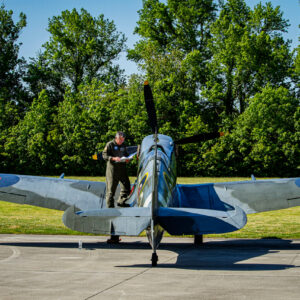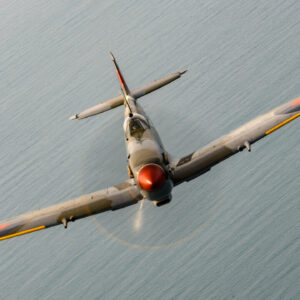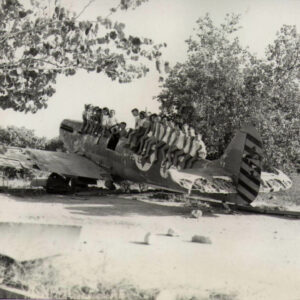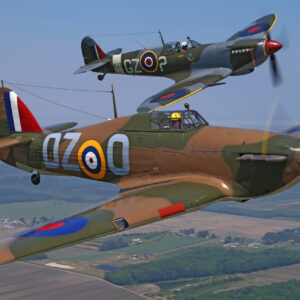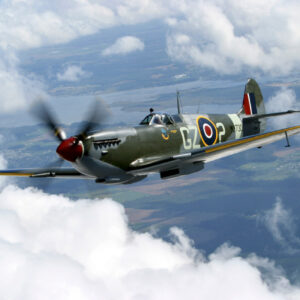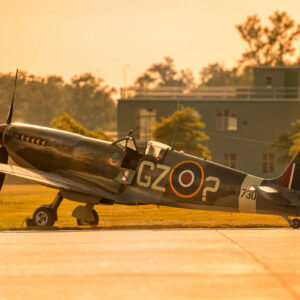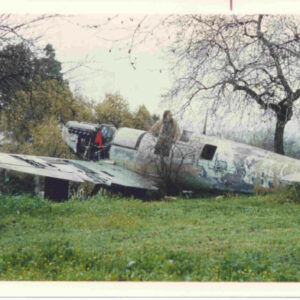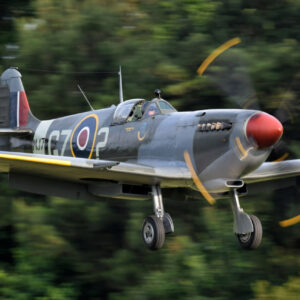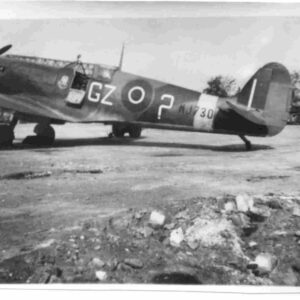Known by her war-time serial number MJ730, the Museum’s Spitfire is a veteran of over 100 combat missions. Originally manufactured at Castle Bromwich Aircraft Factory by Vickers-Armstrong, MJ730 was test flown by Alex Henshaw on December 10, 1943. She was then shipped to Casablanca aboard the S.S. Leeds City.
MJ730 saw her first combat missions with No. 417 Squadron, Royal Canadian Air Force defending the Anzio Beachhead from a base at Marcianise, Italy. Reassigned to No. 154 Squadron, Royal Air Force (RAF) MJ730 would fly 95 combat missions supporting the invasion of Southern France from a base at Poretta, Corsica. In October 1944 the airplane was passed to No. 32 Squadron RAF based at Kalamaki, Greece. During this time, it would fly 12 combat missions over the Balkans before being finally reassigned to No. 94 Squadron, RAF at Sedes, Greece.
MJ730 would later be transferred to the Italian Air Force, and eventually into Israeli Service. Years later the airplane would be located in Kibbutz Kabri near the Lebanese border where it was serving as a piece of playground equipment. The airplane was recovered for restoration in 1978.
Squadron Leader George Frederick Silvester, DFC: When MJ730 arrived at No. 32 Squadron, RAF, she was selected by Squadron Leader George Silvester as his personal aircraft. Before the individual aircraft code could be applied, he had remarked to his ground crew that “there was a bit of a question mark” over which flight identifier should be applied, since the CO belongs to neither A flight nor B flight. The ground crew then applied a question mark to his aircraft as a joke, but the gesture amused the Squadron Leader who chose to keep it! The airplane has since been referred to as “The CO’s Query.”
Silvester was born in Gravesend, England on November 9, 1920. He began flight training in April 1939, and was called to full-time service with the outbreak of war. He would be trained in part at Flight Training School Brize Norton. Silvester was a participant in the Battle of Britain and he would fly for several squadrons as a sergeant pilot before receiving his commission. Later, Silvester was actively engaged in training American pilots of the 52nd Pursuit Group to fly Spitfires through the summer of 1942. He would serve with No. 32 Squadron towards the end of the war, traveling with the unit from Foggia, Italy to Greece. Silvester survived the war and married Section Officer Elizabeth Maureen O’Donohughe WAAF in July 1946.
Did You know?
During her time on Corsica, MJ730 was captured on color film! The clip was filmed by William Wyler (Director of Memphis Belle) for his film Thunderbolt.
Specifications
- Number Built: 20,351 total (5,739 MK IX variants)
- Year Produced: 1943
- Serial Number: MJ730/CBAF 7243
- Crew: (1) Pilot
- Current Pilots:
Dimensions
- Length: 31 ft. 1 in.
- Wingspan: 32 ft. 7 in.
- Empty Weight: 5,634 lbs.
- Loaded Weight: 9,500 lbs.
- Engine: 1x Rolls-Royce Merlin 66 supercharged V-12 inline piston engine
- Engine Power: 1,720 hp
Performance
- Cruising Speed: 324 mph
- Max Speed: 416 mph
- Range: 434 miles
- Ceiling: 42,500 ft
- Rate of Climb: 3,200 ft./min. initial
Armament
- 2x 20 mm cannon – 1x in each wing
- 2x 0.50 caliber machine guns – 1x in each wing
- Up to 1,000 lbs of bombs: 2x 250 lb. bombs – 1x on each wing, and 1x 500 lbs. bomb mounted on a fuselage center rack
- *MAM aircraft is unarmed

